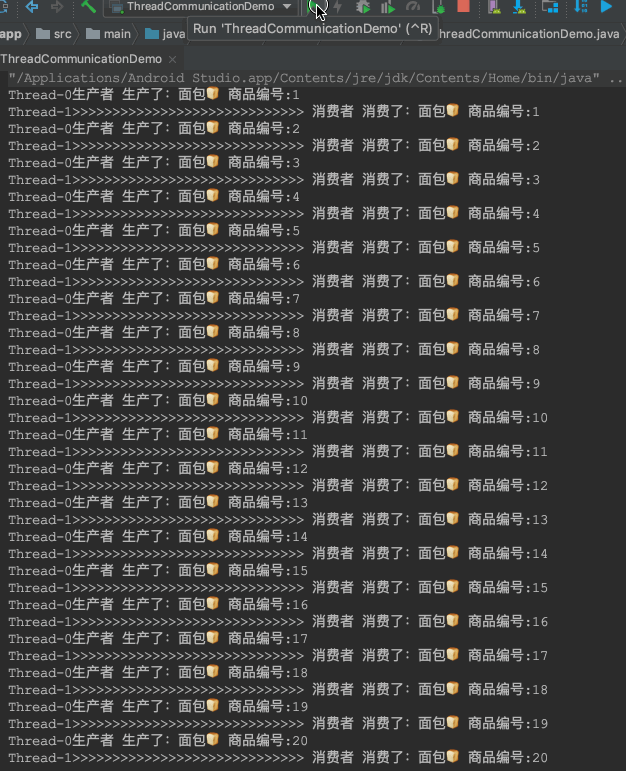多线程通讯:例如:有一个线程任务在run生产,还有一个线程任务在run消费:

VIP尊贵的身份,生产者 消费者 方式,(精心生产制作一个超级无敌好吃的面包,卖给VIP尊贵的身份消费者)生产与消费 一对一的 以下代码 案例一:
package android.java.thread16; /** * 描述资源 */ class Res { private String name; private int id; public void put(String name) { id += 1; this.name = name + " 商品编号:" + id; System.out.println(Thread.currentThread().getName() + "生产者 生产了:" + this.name); } public void out() { id -= 1; System.out.println(Thread.currentThread().getName() + ">>>>>>>>>>>>>>>>>>>>>>>>>>>>> 消费者 消费了:" + this.name); } } /** * 描述生产者任务 */ class ProduceRunnable implements Runnable { /** * 此变量已经不是共享数据了,因为: * new Thread(produceRunnable).start(); * new Thread(consumeRunnable).start(); * * 所以:Thread-0有自己的res Thread-1也有自己的res */ private Res res; ProduceRunnable(Res res) { this.res = res; } /** * 执行线程任务 */ @Override public void run() { res.put("面包🍞"); } } /** * 描述消费者任务 */ class ConsumeRunnable implements Runnable { /** * 此变量已经不是共享数据了,因为: * new Thread(produceRunnable).start(); * new Thread(consumeRunnable).start(); * * 所以:Thread-0有自己的res Thread-1也有自己的res */ private Res res; ConsumeRunnable(Res res) { this.res = res; } /** * 执行线程任务 */ @Override public void run() { res.out(); } } /** * 多线程通讯案例 */ public class ThreadCommunicationDemo { public static void main(String[] args) { // 创建资源对象 Res res = new Res(); // 创建生产者任务 ProduceRunnable produceRunnable = new ProduceRunnable(res); // 创建消费者任务 ConsumeRunnable consumeRunnable = new ConsumeRunnable(res); // 启动生产者任务 new Thread(produceRunnable).start(); // 启动消费者任务 new Thread(consumeRunnable).start(); } }
执行结果:

以上案例一存在安全问题: 分析以下程序是否存在安全🔐问题:
由于以上程序本身就是多线程程序,所以寻找共享数据,然后对操作共享数据的地方加入同步锁的方式来解决安全问题 案例二
package android.java.thread16; /** * 描述资源 */ class Res { /** * name 是共享数据,被Thread-0 Thread-1公用使用 */ private String name; /** * id name 是共享数据,被Thread-0 Thread-1公用使用 */ private int id; /** * 对操作共享数据的地方加入同步锁的方式来解决安全问题 * public synchronized(this) void put(String name) { */ public synchronized void put(String name) { id += 1; this.name = name + " 商品编号:" + id; System.out.println(Thread.currentThread().getName() + "生产者 生产了:" + this.name); } /** * 对操作共享数据的地方加入同步锁的方式来解决安全问题 * public synchronized(this) void put(String name) { */ public void out() { id -= 1; System.out.println(Thread.currentThread().getName() + ">>>>>>>>>>>>>>>>>>>>>>>>>>>>> 消费者 消费了:" + this.name); } } /** * 描述生产者任务 */ class ProduceRunnable implements Runnable { /** * 此变量已经不是共享数据了,因为: * new Thread(produceRunnable).start(); * new Thread(consumeRunnable).start(); * * 所以:Thread-0有自己的res Thread-1也有自己的res */ private Res res; ProduceRunnable(Res res) { this.res = res; } /** * 执行线程任务 */ @Override public void run() { for (int i = 0; i < 20; i++) { res.put("面包🍞"); } } } /** * 描述消费者任务 */ class ConsumeRunnable implements Runnable { /** * 此变量已经不是共享数据了,因为: * new Thread(produceRunnable).start(); * new Thread(consumeRunnable).start(); * * 所以:Thread-0有自己的res Thread-1也有自己的res */ private Res res; ConsumeRunnable(Res res) { this.res = res; } /** * 执行线程任务 */ @Override public void run() { for (int i = 0; i < 20; i++) { res.out(); } } } /** * 多线程通讯案例 */ public class ThreadCommunicationDemo { public static void main(String[] args) { // 创建资源对象 Res res = new Res(); // 创建生产者任务 ProduceRunnable produceRunnable = new ProduceRunnable(res); // 创建消费者任务 ConsumeRunnable consumeRunnable = new ConsumeRunnable(res); // 启动生产者任务 new Thread(produceRunnable).start(); // 启动消费者任务 new Thread(consumeRunnable).start(); } }
执行结果:每次不一样由CPU随机性决定的,CPU随机的执行:例如:这个线程执行一下,也有可能哪个线程执行一下,也可能这个线程执行完,等等:
加入了synchronized解决了安全问题:

以上案例二,虽然解决了安全🔐问题,但是:CPU随机执行线程,搞得很混乱,没有满足(生产一个,消费一个)的功能
等待 唤醒 图:
1.定义共享数据 boolean flag = false;
2.生产者 if(flag == false) { 开始生产 生产完毕后 notify唤醒,由于第一次没有线程wait()等待, 属于空唤醒,在Java里面是运行空唤醒的 }
3.生产者,设置为冻结状态:释放CPU执行资格,释放CPU执行权 ,CPU就可以去执行Thread-0线程了
4.消费者 if(flag == false) { 开始消费 消费完毕后 notify唤醒(注意:⚠️如果不notify唤醒 就属于死锁了,因为两个线程都冻结了),然后在wait(); 冻结状态:释放CPU执行资格,释放CPU执行权 ,CPU就会去执行Thread-1线程了}
这样来回的切换,生产者生产后,告诉消费者,消费者消费后,告诉生产者 ............

以上图关系到线程的状态:需要看博客:Android-Thread线程的状态
案例三:等待唤醒机制:
wait(); 等待/冻结 :可以将线程冻结,释放CPU执行资格,释放CPU执行权,并把此线程临时存储到线程池
notify(); 唤醒线程池里面 任意一个线程,没有顺序;
notifyAll(); 唤醒线程池里面,全部的线程;
注意:⚠️ wait(); notify(); 这些必须要有同步锁包裹着
package android.java.thread16; /** * 描述资源 */ class Res { /** * name 是共享数据,被Thread-0 Thread-1公用使用 */ private String name; /** * id 是共享数据,被Thread-0 Thread-1公用使用 */ private int id; /** * flag 是共享数据,被Thread-0 Thread-1公用使用 */ private boolean flag; // 定义标记 默认第一次为false /** * 对操作共享数据的地方加入同步锁的方式来解决安全问题 * public synchronized(this) void put(String name) { */ public synchronized void put(String name) { /** * 生产之前判断标记 */ if (!flag) { // 开始生产 id += 1; this.name = name + " 商品编号:" + id; System.out.println(Thread.currentThread().getName() + "生产者 生产了:" + this.name); // 生产完毕 /** * 修改标记 */ flag = true; /** * 唤醒 wait(); 冻结的线程,如果没有就是空唤醒,Java是支持的 */ notify(); // 注意:⚠️ wait(); notify(); 这些必须要有同步锁包裹着 /** * 当前自己线程 冻结,释放CPU执行资格,释放CPU执行权,CPU就会去执行其他线程了 */ try { wait(); // 注意:⚠️ wait(); notify(); 这些必须要有同步锁包裹着 } catch (InterruptedException e) { e.printStackTrace(); } } } /** * 对操作共享数据的地方加入同步锁的方式来解决安全问题 * public synchronized(this) void put(String name) { */ public synchronized void out() { /** * 消费之前判断标记 */ if (flag) { // 开始消费 System.out.println(Thread.currentThread().getName() + ">>>>>>>>>>>>>>>>>>>>>>>>>>>>> 消费者 消费了:" + this.name); // 消费完毕 /** * 修改标记 */ flag = false; /** * 唤醒 wait(); 冻结的线程,如果没有就是空唤醒,Java是支持的 */ notify(); // 注意:⚠️ wait(); notify(); 这些必须要有同步锁包裹着 /** * 当前自己线程 冻结,释放CPU执行资格,释放CPU执行权,CPU就会去执行其他线程了 */ try { wait(); // 注意:⚠️ wait(); notify(); 这些必须要有同步锁包裹着 } catch (InterruptedException e) { e.printStackTrace(); } } } } /** * 描述生产者任务 */ class ProduceRunnable implements Runnable { /** * 此变量已经不是共享数据了,因为: * new Thread(produceRunnable).start(); * new Thread(consumeRunnable).start(); * * 所以:Thread-0有自己的res Thread-1也有自己的res */ private Res res; ProduceRunnable(Res res) { this.res = res; } /** * 执行线程任务 */ @Override public void run() { for (int i = 0; i < 20; i++) { res.put("面包🍞"); } } } /** * 描述消费者任务 */ class ConsumeRunnable implements Runnable { /** * 此变量已经不是共享数据了,因为: * new Thread(produceRunnable).start(); * new Thread(consumeRunnable).start(); * * 所以:Thread-0有自己的res Thread-1也有自己的res */ private Res res; ConsumeRunnable(Res res) { this.res = res; } /** * 执行线程任务 */ @Override public void run() { for (int i = 0; i < 20; i++) { res.out(); } } } /** * 多线程通讯案例 */ public class ThreadCommunicationDemo { public static void main(String[] args) { // 创建资源对象 Res res = new Res(); // 创建生产者任务 ProduceRunnable produceRunnable = new ProduceRunnable(res); // 创建消费者任务 ConsumeRunnable consumeRunnable = new ConsumeRunnable(res); // 启动生产者任务 new Thread(produceRunnable).start(); // 启动消费者任务 new Thread(consumeRunnable).start(); } }
执行结果,和谐了 生产一个 消费一个:


 浙公网安备 33010602011771号
浙公网安备 33010602011771号